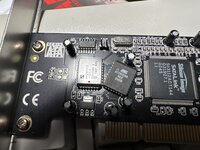nikdoof
New member
A little more experimentation, I added a Apple branded SATA 2.5" HDD onto the SIL3112 card and booted with my known good OSX 10.4 from the SATA2IDE, the boot was extremely slow but it did get into OSX, and in System Information the HDD didn't show. Again, works perfectly fine and without issue in OS9. Removing the power from the HDD the system booted into OSX near instantly again.

